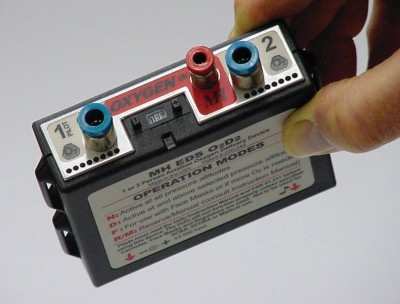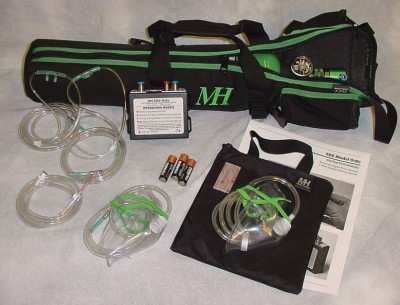Mon, Feb 21, 2011
Multiple Person Full Authority Digital Oxygen Control
The MH EDS O2D2 Pulse Demand FADOC Oxygen Delivery System
developed by Mountain High is oxygen technology for rotorcraft for
two or more people. The company says it is the only portable single
unit, two-place, digital Pulse-Demand oxygen system available that
functions with rotary wing aircraft.

The MH O2D2, with the patented digital electronic Pulse-Demand
FADOC (Full Authority Digital Oxygen Control) delivery system was
tested by CAMI (FAA Civil Aerospace Medical Institute). It enables
the pilot and passengers to fly at pressure altitudes up to 25,000
feet with absolute oxygen safety and comfort. The O2D2 digital
Pulse-Demand system reduces oxygen consumption dramatically.
Different from the "standard" constant flow systems, the O2D2
Pulse-Demand system wastes no oxygen during the breathing
cycle.
Tests show that 90% of the oxygen supplied by the O2D2 is
transferred to the blood. The average user will enjoy a
conservative consumption drop of four (4) times or more compared to
the manual constant flow systems. The system operates, with
two people, for up to 50 + hours on three AA alkaline
batteries.
Mountain High says the two-person O2D2 reduces oxygen system
workload to virtually nothing. There are no oxygen flow indicators
to watch or manually operated constant flow valves to adjust due to
altitude changes. The O2D2 functions through the various modes
automatically delivering the required oxygen pulses (Pulse-Demand)
for changing altitudes for both the pilot and passenger or with
add-on O2D2's, additional passengers. The portable system consists
of an aluminum oxygen cylinder (buyer has a choice of sizes), a
cylinder carry case, seat back holding straps, primary reducing
regulator, low pressure service line, connection fittings, the MH
EDS O2D2 FADOC unit, breathing cannulas, face masks, batteries and
a tote bag...everything needed for a complete supplementary oxygen
system. A custom built-in system is also available.

MH EDS O2D2 Oxygen Delivery Systems for Rotor aircraft start at
$995. A variety of options are available to meet specific pilot
needs, including lightweight composite cylinders, four place
regulators, adapters, cannulas and comfortable mic facemasks.
More News
Light Gun A handheld directional light signaling device which emits a brilliant narrow beam of white, green, or red light as selected by the tower controller. The color and type of>[...]
"The journey to this achievement started nearly a decade ago when a freshly commissioned Gentry, driven by a fascination with new technologies and a desire to contribute significan>[...]
Aero Linx: JAARS, Inc. For decades now, we’ve landed planes on narrow rivers and towering mountains. We’ve outfitted boats and vehicles to reach villages that rarely se>[...]
"Our driven and innovative team of military and civilian Airmen delivers combat power daily, ensuring our nation is ready today and tomorrow." Source: General Duke Richardson, AFMC>[...]
Aircraft Conflict Predicted conflict, within EDST of two aircraft, or between aircraft and airspace. A Red alert is used for conflicts when the predicted minimum separation is 5 na>[...]
 ANN's Daily Aero-Term (04.20.24): Light Gun
ANN's Daily Aero-Term (04.20.24): Light Gun Aero-News: Quote of the Day (04.20.24)
Aero-News: Quote of the Day (04.20.24) ANN's Daily Aero-Linx (04.21.24)
ANN's Daily Aero-Linx (04.21.24) Aero-News: Quote of the Day (04.21.24)
Aero-News: Quote of the Day (04.21.24) ANN's Daily Aero-Term (04.21.24): Aircraft Conflict
ANN's Daily Aero-Term (04.21.24): Aircraft Conflict




